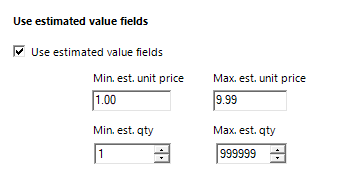Estimated quantity and unit price
You make be looking to buy collections of items, such as books, comics, magazines, and other collectables. If you are buying to resell, then making sure that you get individual items at the lowest possible unit price is important. The Jumble Saler search system tries to estimate the quantity of titles from auction titles, so that it can display an estimated unit price. It won't get this correct 100% of the time as auctions are created my millions of different people and therefore there is no standardation in the titles.
Let's look at an example of a recent eBay auction:
"beano comics job lot 20 COMICS FROM 2011"
Current price: 4.00
Shipping price: 5.20
So which this appeared in our search results grid, it looked like:

You can see the 'Total' is made up of the current auction price plus the shipping/delivery charge. You can also see that the estimated quantity (est qty) is 20. There are two numbers in the listings, 20 and 2011 and Jumble Saler correctly worked out which was the quantity.
The estimated unit price (Est unit column) therefore is the total price including shipping of 9.20 divided by the estimated quantity of 20. In this case the estimated unit price is 0.46 for each of the comics.
You can also order the results grid by estimated quantity or estimate unit price.
Estimated issue number, issue number to, volume, and issues dates
For items like magazines and comics, there is often an issue number and issue date in the title for single issues. Here's another example auction:
"Sonic The Comic No. 1 29th May 1993 Fleetway Edition VFN With Stickers"
We, as humans, can see this is for a single comic, which is issue number 1, and is dated 29th May 1993. This is how it appeared in the search grid:

Jumble Saler recognises dates in different formats and different ways that people type in dates in their auctions. For example US and US dates and formatted differently.
You can order the grid by any of these columns including issue number and issue date.
Setting your search rules to use estimated maximum unit price
When you create or edit a search rule, you can use maximum or minimum unit prices and also maximum and minimum estimated unit prices to narrow large numbers of raw searches down to a few that you may want to look at. When you add or edit a search rule record, then you can scroll down and use the estimated value fields section:

NOTE - Estimated unit price is: number of times divided by total price (i.e. item price + item delivery)
Max est. unit price - This is useful to really narrow down results from the raw auction count. So if you were looking for a particular comics and set this to say 5, then it would show you all the single comics, so would pick up:
| Title | Total | Estimated | Estimated |
| quantity | unit price | ||
| spiderman comic #3 | 5.00 | 1 | 5.00 |
| 2 x spiderman comics | 9.00 | 2 | 4.50 |
| 10 spiderman comics | 25.00 | 10 | 2.50 |
But would exclude:
| Title | Total | Estimated | Estimated |
| quantity | unit price | ||
| spiderman comic #2 | 15.00 | 1 | 15.00 |
| 2 x spiderman comics | 19.00 | 2 | 9.50 |
| 10 spiderman comics | 500.00 | 10 | 50.00 |
Jumble Saler won't always get this right and it can't do an estimate for a title like "Box full of spiderman comics", so will put the estimated quantity to 1. If you use the maximum estimated unit price, you may also want to set up another rule record for collections and joblots as well.
This part of the system is designed where there is a high number of raw searches. "Spiderman comic" will return around 30,000 raw search items, for example. You can use this to narrow down large numbers of auctions and then Jumble Salers can just add to the grids a much more narrowed number of auctions for you to look at:
Max est. quantity - This is useful if you are only looking for collections that have a minimum quantity of items in, say 50 or 100, as you may only want to buy in bulk and then also est a maximum estimated unit price as well, so that you are only looking at cheaper collections.
Limitations of Jumble Saler
Currently, we are fine tuning our software for English language eBay sites, and it won't work with non-English titles. Auctions with titles such as 'Large comic collection', 'Job lot of old books', etc, where there isn't information quantity information in them, will have an estimated quantity of 1, which obviously isn't correct. You will need to set up a separate rule looking for collections, joblots, bundles, "box full of", etc.